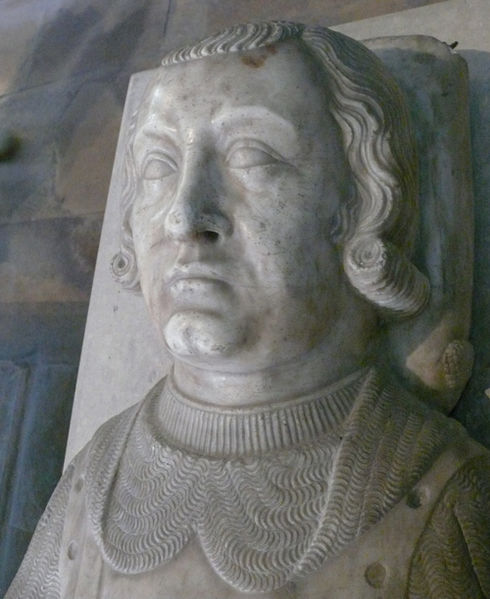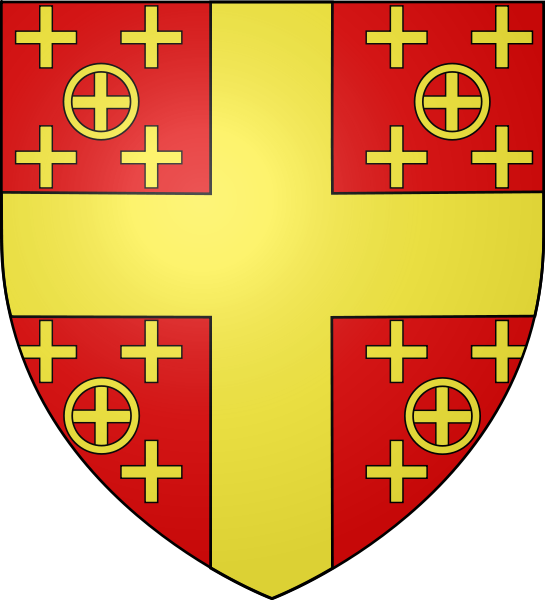<Back to Index>
- Mineralogist and Geochemist Vladimir Ivanovich Vernadsky, 1863
- Painter Anton Raphael Mengs, 1728
- Count of Valois Charles, 1270
PAGE SPONSOR


Charles of Valois (12 March 1270 – 16 December 1325) was the fourth son of Philip III of France and Isabella of Aragon. His mother was a daughter of James I of Aragon and Yolande of Hungary. He was a member of the House of Capet and founded the House of Valois. In 1284, he was created Count of Valois (as Charles I) by his father and, in 1290, received the title of Count of Anjou from his marriage to Margaret of Anjou.
Moderately intelligent, disproportionately ambitious and quite greedy, Charles of Valois collected principalities. He had as appanage the counties of Valois, Alençon and Perche (1285). He became in 1290 count of Anjou and of Maine by his marriage with Margaret, eldest daughter of Charles II, titular king of Sicily; by a second marriage, contracted with the heiress of Baldwin II de Courtenay, last Latin emperor of Constantinople, he also had pretensions on this throne. But he was son, brother, brother - in - law and son - in - law of kings or of queens (of France, of Navarre, of England, and of Naples), becoming, moreover, after his death, father of a king (Philip VI).
He thus dreamed of more and sought all his life for a crown he never obtained. In 1285 the pope recognized him as King of Aragon (under the vassalage of the Holy See), as son of his mother, in opposition to King Pedro III, who after the conquest of the island of Sicily was an enemy of the papacy. Charles then married Marguerite of Sicily, daughter of the Neapolitan king, in order to re-enforce his position in Sicily, supported by the Pope. Thanks to this Aragonese Crusade undertaken by his father Philip III against the advice of his brother, the future Philip the Fair, he believed he would win a kingdom and won nothing but the ridicule of having been crowned with a cardinal's hat in 1285, which gave him the sobriquet of the "King of the Cap." He would never dare to use the royal seal which was made on this occasion and would have to renounce the title.
His principal quality was to be a good military leader. He commanded effectively in Flanders in 1297. The king quickly deduced that his brother could conduct an expedition in Italy against Frederick II of Sicily. The affair was ended by the peace of Caltabellotta (1302).
Charles dreamed at the same time of the imperial crown and married in 1301 Catherine de Courtenay, titular empress, granddaughter and heiress of the last Latin emperor of Constantinople, Baldwin II de Courtenay. But it needed the connivance of the Pope, which he obtained by his expedition to Italy, where he supported Charles II of Anjou against Frederick II of Sicily, his cousin. Named papal vicar, he lost himself in the imbroglio of Italian politics, was compromised in a massacre at Florence and in sordid financial exigencies, reached Sicily where he consolidated his reputation as a looter and finally returned to France discredited in 1301 - 1302.
Charles was back in shape to seek a new crown when the German king Albert of Habsburg was murdered in 1308. Charles's brother, who did not wish to take the risk himself of a check and probably thought that a French puppet on the imperial throne would be a good thing for France, encouraged him. The candidacy was defeated with the election of Henry VII as German king. Charles continued to dream of the eastern crown of the Courtenays.
He did benefit from the affection which Philip the Fair, who had suffered from the remarriage of their father, brought to his only full brother, and he found himself given responsibilities which largely exceeded his talent. Thus it was he who directed in 1311 the royal embassy to the conferences of Tournai with the Flemish; he quarreled there with his brother's chamberlain Enguerrand de Marigny, who openly flouted him. Charles did not pardon the affront and would continue the vendetta against Marigny after the king's death.
He was doggedly opposed to the torture of Jacques de Molay, grand master of the Templars, in 1314.
The premature death of Louis X in 1316 gave Charles hopes for a political role, but he could not prevent his nephew Philip, from taking the regency while awaiting the birth of Louis X's posthumous son. When that son (John I of France) died after a few days, Philip took the throne as Philip V.
In 1324, he commanded with success the army of his nephew Charles IV (who succeeded Philip V in 1322) to take Guyenne and Flanders from King Edward II of England. He contributed, by the capture of several cities, to accelerate the peace, which was concluded between the king of France and his sister, Isabella, queen consort of England.
The Count of Valois died 16 December 1325 at Nogent - le - Roi, leaving a son who would take the throne of France under the name of Philip VI and
commence the branch of the Valois: a posthumous revenge for the man of
whom it was said, "Son of a king, brother of a king, uncle of three
kings, father of a king, but never king himself." Charles de Valois was married three times. His first marriage, in 1290, was to Margaret, Countess of Anjou, (1274 – 1299), daughter of King Charles II of Naples. They had six children. In 1302 he remarried to Catherine I of Courtenay (1274 – 1307), titular Empress of Constantinople. They had four children. Finally, in 1308, he married Mahaut of Châtillon (1293 – 1358), daughter of Guy III of Châtillon, Count of Saint Pol. They had also four children. Charles de Valois was also known to have one illegitimate child by an unknown mother. This
child was placed in a nunnery, and yet was also treated as a legitimate
heir to estates, being granted title to lands in Avignon upon her
majority.